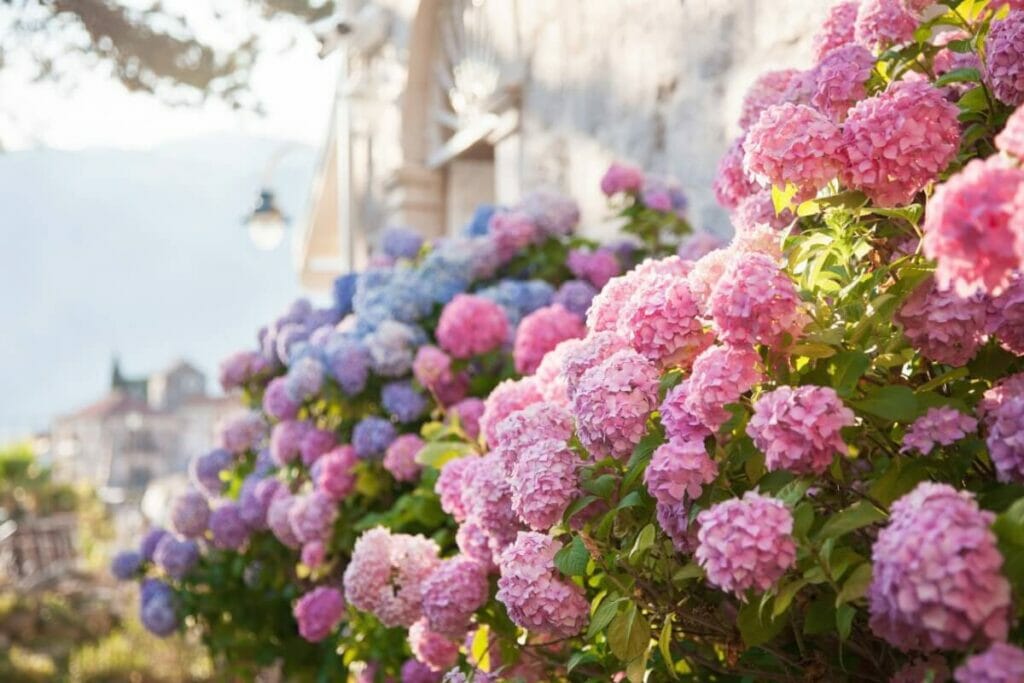Are Hydrangeas Easy to Work With Flowers
Everything You Need to Know About the Uses and Benefits of Hydrangea Plants
Hydrangeas are famed worldwide for their fabulous flowers and beautifully rounded flower heads. Many hydrangeas are native either to parts of Asia or North America but are widely cultivated across the world. These pretty perennials also have a wide range of aesthetic and medicinal uses and benefits. In this article, we'll run through 15 incredible uses and benefits of hydrangeas.
About Hydrangeas:

Hydrangeas are commonly known by their genus name and occasionally their previous genus name Hortensia. They are the most used genus in the family Hydrangeaceae, with over 75 species grown worldwide.
Although there is some variation between the popular hydrangea species, only a few are usually grown in home gardens:
- Bigleaf (Hydrangea macrophylla)
- Oakleaf (Hydrangea quercifolia)
- Smooth (Hydrangea arborescens)
- Panicle (Hydrangea paniculata)
- Climbing (Hydrangea anomala subsp. petiolaris)
- Mountain (Hydrangea serrata)
Bigleaf Hydrangeas are a crowd-favorite and the most widely grown species. But each species comes with its own quirks, from uniquely shaped flowers to different growing zones, and flowering seasons, that make them all beautiful choices for home gardeners.
15 Incredible Uses and Benefits of Hydrangeas

1. Hydrangeas Can Suit Most Gardens
One of the great things about growing hydrangeas is that there are a lot of varieties to choose from. The Hydrangea genus contains more than 75 species, so there's definitely one to suit every garden. Most hydrangeas used in gardens come from seven of the most popular species and their cultivars.
Bigleaf hydrangeas (Hydrangea macrophylla) are the most common type of hydrangea grown in gardens worldwide. These plants are also known as French or mophead hydrangeas and produce large rounded pink to purple flower heads. Bigleaf hydrangeas are deciduous perennial shrubs that can grow up to 8 ft tall.
Mountain hydrangeas (Hydrangea serrata) are a smaller variety that's well-suited to gardens with limited space. Mountain hydrangeas grow between 2 and 4 ft tall and wide. They're a good variety to grow in containers. Regardless of the space you have, there's a hydrangea that's perfect for you.
2. Hydrangeas Are Excellent Ornamental Plants

Most hydrangeas are deciduous shrubs that can grow between 3 and 8 ft tall. This makes them excellent as ornamental centerpieces for any garden. Add in the spectacular color of the large flower heads, and hydrangeas can really enhance the structure of your garden.
Although many hydrangeas grow as large shrubs, others grow as climbers or small trees. Climbing hydrangeas (Hydrangea petiolaris or Hydrangea anomala) are perfect for training up trellises or walls. Meanwhile, oakleaf hydrangeas (Hydrangea quercifolia) grow as small upright trees – reaching up to 12 ft tall.
Hydrangeas also make excellent ornamental plants because of their showy flower heads and range of colors. Most varieties produce rounded clusters of white, pink, purple, or even blue flowers. Some varieties, like oakleaf hydrangeas or panicled hydrangeas (Hydrangea paniculata), have cone-shaped flower spikes rather than snowball-like clusters.
3. Hydrangeas Are Pretty Easy to Grow
Despite their beautiful looks and impressive size, many hydrangeas aren't actually difficult to grow. Most hydrangeas can handle a combination of sun and partial shade. They can thrive in a range of soils as long as they're kept relatively moist, especially in hot summers.
Hydrangeas can handle both acidic and alkaline soils and have the peculiar ability to change their color based on the pH level of the soil. Hydrangeas growing in more acidic soils tend to produce blue or purple flowers. Plants grown in alkaline soils tend to have pink or reddish flowers.
Hydrangeas aren't heavy feeders and typically only need fertilizing twice during each growing season. Most hydrangeas grow well in USDA Zones 3 to 9.
4. Hydrangeas Make Fantastic Cut Flowers

The spectacular rounded flower heads of hydrangeas make excellent cut flowers. Most varieties flower sometime between early spring and late fall, making them ideal for a summer display in a vase. Hydrangeas come in various colors such as white, pink, purple, red, green, and even blue.
Some varieties also produce lovely subtle scents, adding an extra layer to your cut flower display. Although hydrangea stems may only last a few days, they can be revived. A healthy hydrangea shrub will also produce a vast bounty of flowers so that you can keep your vase filled for weeks on end.
5. Hydrangea Flowers Can Be Dried
As well as being great cut flowers, hydrangea blooms can also be dried to preserve their beauty. Hydrangea flowers take a couple of weeks to dry and can then last for a year or more. This is a great way to create an ongoing display with hydrangea flowers.
Hydrangeas work best when cut and dried in late summer or fall. Take stem cuttings that are at least 12 to 18 inches long and prune off the leaves. Place the cuttings in a vase of water with the liquid covering about half of the stem.
Leave the cuttings in the vase for two or three weeks until all the water has evaporated. Your dried hydrangeas are then ready to display.
6. Hydrangeas Are Low-Maintenance Plants

Not only are hydrangeas stunning and easy to grow, but they're also low-maintenance. Many hydrangea varieties only need to be pruned once or twice a year. Their care needs are relatively simple, and primarily center around watering hydrangeas consistently once established, so you won't need to spend much time looking after them.
If your hydrangeas flower on old growth, prune them once they have finished flowering by cutting back to an unopened set of buds. For hydrangeas that flower on new growth, cut them back fairly hard in late winter or early spring to encourage rapid new growth.
Hydrangeas are also easy to divide and propagate if you're looking to expand your collection and also relatively straightforward to move or transplant when needed.
It's worth noting that hydrangeas are considered toxic, so it's prudent to wear a pair of gardening gloves throughout the process.
7. Some Hydrangeas Can Have a Long Flowering Season
Most hydrangeas flower sometime between early spring and late fall. Some varieties can bloom continuously throughout most of the season. Smooth hydrangeas (Hydrangea arborescens) and oakleaf hydrangeas are great varieties to grow if you want long-lasting flowers.
Some hydrangeas can change their colors as their flowers age. Oakleaf hydrangeas produce creamy-white flowers at the start of the blooming season. These flowers then fade to pink as fall approaches and turn brown during the winter.
8. Hydrangeas Can Attract Pollinators to Your Garden

Hydrangeas can also be a great way to attract pollinators like bees, butterflies, and hoverflies to your garden. Their prominent flower heads contain several small flowers that most pollinators can access easily. However, some hydrangea varieties are better for pollinators than others.
Many of the commonly cultivated hydrangeas tend to have sterile flowers. Bigleaf hydrangeas or smooth hydrangeas are the main culprits. Sterile flowers don't produce pollen, meaning a wasted journey and energy for bees and other insects.
The best varieties of hydrangeas for pollinators are usually climbing hydrangeas or panicled hydrangeas. Many cultivars from these varieties still produce pollen. This provides a vital food source for pollinators while you enjoy the beautiful colors and the buzz of insects.
9. Hydrangeas Don't Suffer From Many Pests
One of the reasons why hydrangeas are easy to grow, low-maintenance plants is that they don't suffer from too many pests or problems. While things like leaf spot, mildew, aphids, and spider mites can occur, they're pretty easy to avoid.
Hydrangeas are relatively hardy and can grow happily in various soils and conditions. Many hydrangea varieties can tolerate full sunlight, although partial shade is best. Most hydrangeas can easily fight off pests and diseases if the soil is kept relatively moist.
10. Hydrangea Root May Alleviate Urinary Tract Issues

Hydrangea has long been thought to have medicinal benefits in traditional folk medicine. One of the possible uses for hydrangea root extract is to alleviate prostate or urinary tract issues. Hydrangea is believed to have diuretic properties, which may improve urine flow and potentially reduce symptoms of urinary tract infections.
However, keep in mind that scientific studies don't yet back up these potential benefits. Always seek the advice of your doctor before thinking about using supplements derived from hydrangeas.
11. Hydrangea Supplements May Help Protect Your Liver and Kidneys
Hydrangea supplements may help reinforce organs such as the kidney and liver against various problems. Studies involving mice have shown that hydrangea supplements could reduce blood urea nitrogen levels, which can cause kidney damage.
Some research has found that the compounds in hydrangeas may mediate liver toxicity, potentially protecting us against various health conditions. Many of these studies were conducted using panicled hydrangeas but haven't been tested on humans.
12. Hydrangeas May Have Anti-Inflammatory Properties

Various studies have shown that molecules in hydrangea roots, like skimmin, may help reduce inflammation. The study tested the effects of skimmin on kidney inflammation in mice and found measurable drops in inflammation.
Another molecule found in hydrangeas – coumarin – has also been shown by other studies to be anti-inflammatory. However, research into the anti-inflammatory properties of hydrangeas has not yet been conducted involving humans.
13. Hydrangeas Could Help Lower Blood Sugar Levels
Studies in laboratories and on mice have indicated that hydrangea extract could help lower blood sugar levels. This effect is down to the molecule skimmin, which may also have anti-inflammatory properties. The study also showed that skimmin might be able to increase blood sugar uptake.
This could be good for people who have diabetes, although these studies have not yet been tested on humans.
14. Hydrangeas May Be High in Antioxidants

Another potential benefit of hydrangea supplements is that they may be high in antioxidants. If we have too many oxidants in our bodies, it could lead to health problems such as tissue damage. Hydrangeas contain coumarin, a molecule that studies have shown to potentially have antioxidant properties.
Another study conducted on mice found that hydrangea extract may significantly lower the number of compounds that can cause oxidative stress. This occurs if too many oxidants are present in the body. However, none of these beneficial effects have been tested on humans.
15. Hydrangea Flowers Make Excellent Gifts for Numerous Occasions
Hydrangeas are popular flowers in many cultures and have developed a lot of meanings and symbolism. This makes hydrangeas an excellent gift for several occasions, especially if you want to convey a specific message. Different colors of hydrangeas can represent different meanings.
Purple hydrangeas can symbolize sympathy, so they make perfect gifts if someone is facing a difficult period in their life. Blue hydrangeas are associated with sincere apologies, so can be used as a conciliatory gift. Green hydrangeas are a beautiful symbol of friendship, so make a great birthday gift if you're close to someone.
Hydrangeas and geraniums are associated with a fourth wedding anniversary. Pink or white hydrangeas work well as gifts for this occasion.
The Uses and Benefits of Hydrangeas – The Final Word
Hydrangeas are popular around the world thanks to their gorgeous flowers. But there's more to these beautiful plants than looks alone. Hydrangeas also have lots of benefits and uses, both in the garden and potentially as medicinal plants.
In the garden, hydrangeas make excellent ornamental plants yet are easy to grow and have relatively low-maintenance needs. Hydrangeas also perform well as cut or dried flowers. Hydrangeas may also have medicinal benefits such as reducing inflammation or containing antioxidants.
Source: https://www.petalrepublic.com/benefits-of-hydrangeas/
0 Response to "Are Hydrangeas Easy to Work With Flowers"
Post a Comment